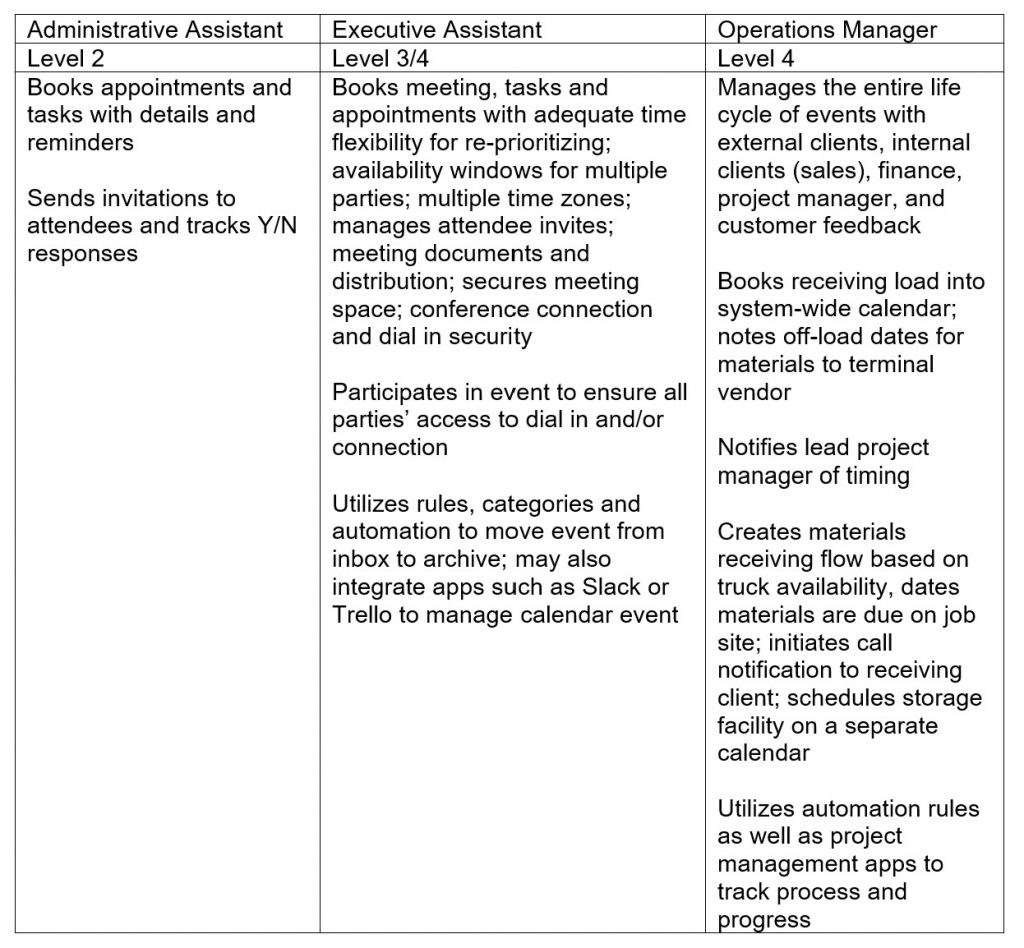
Kemetia Foley looks at the differences between the Assistant role and the Operations Manager role
In the summer of 2020, just as the pandemic was shutting companies down, I took a new position as an office manager for a small retail home improvement showroom. Having worked various other administrative roles in my career – Executive Assistant, research coordinator, and customer service specialist – I determined that I had a solid understanding of the experience and skills necessary to be successful in this role. The surprise arrived when my learning curve was steeper than I anticipated. While there are many overlapping job responsibilities and skills within most administrator positions, this endeavor demanded more, much more.
I am reminded of my reaction to a high-level Chief Executive Assistant discussing their first week on the job, which included hiring a helicopter for their CEO, and the description of their daily endeavors, which seemed beyond belief. The reality is the tasks are the same: time management, calendar management, mastery of communication and diplomatic skills, and the ability to be flexible with prioritization and frequently changing plans. The differences are at the level of authority, scope of responsibility, and speed required for implementation.
At the conclusion of my first year, I took the documentation of my newly acquired duties and additional soft and hard skills, and utilized data pulled from the United States Bureau of Labor Statistics to present my case to the CEO for a title change from Office Manager to Operations Manager (smile!).
[Caveat: This has been my experience, which may differ from yours. It’s important we keep that discussion open, especially as the work of the World Administrators Alliancecontinues and the Global Skills Matrix progression, shown below, is shared with Human Resources and other hiring professionals.]

I also think it’s key to acknowledge that it is a rarity to have our job title accurately reflect our scope of work. Again, this educational endeavor falls within the scope of work of the World Administrators Alliance. For this article, the focus is on the additional skills I had to acquire while moving into the Operations Manager role. Obviously, there will be some broad generalizations, but overall this reflects the level of skill required.
Calendar and Time Management
This may be the singular most important job responsibility of all support professionals. Intertwined in this responsibility are foundations of trust and in-depth knowledge of the business strategic plan.
In my operations role, materials and transport logistics calendars joined my workload. This is a Level 4 skill. Let us look at an example using the standard task of creating a meeting or event for the calendar, across levels referenced above.

The responsibilities at Levels 3 and 4 go beyond the task and require a full understanding of how each scheduled event or appointment impacts workflow for the supervisor, team, and customers. The communication skill level required is Level 4. Appropriate applications are used to update the project status for internal communications, documentation is distributed as needed to assigned team members, and, most importantly, timely delivery of communications with customers regarding project status is ensured. This last step requires the soft skill of discernment: managing the current supply chain issues and, more importantly, utilizing deliberate communications to manage internal and external customer expectations.
Additional or Increased Responsibilities Within the Operations Role at Level 4
Customer service
When working with internal and external customers, I have the authority to manage and prioritize projects based on a 35,000-ft-high point of view, looking at the overall landscape of project and project delivery.
Company finances
When working with company financial data, the skill is to be aware of cash flow. I have the ability to run accurate accounts receivable reports by fiscal year, year-to-year as well as quarterly comparisons. I responsibly manage materials ordering, vendor payments as well as customer payment recovery.
Project logistics management
The skill level change is the mastery of a project management app and inventory tracking application and driving the dissemination of who needs to know what information. It differs from the Assistant role, as, rather than the coordinator of processes, I am the leader/driver of processes, with accountability and measured outcomes.
Human resources: onboarding personnel
The task may be to order a laptop and other required work materials, but the responsibility level is elevated to education regarding a new hire’s role within the strategic planand acting as an HR conduit to confirm and clarify responsibilities within the organization. The role requires positive reinforcement to integrate the new hire into company culture, processes, and procedures – the “how” and “why” things are done the way they are currently done. It does not preclude implementation of any new suggested changes.
Support responsibility: organizational chart
The primary support responsibility is to the entire company, whereas an Assistant role supports a particular department, level, or more than one person at the company to assist the management or team in the execution of strategic plans. The Level 2 or 3 administrative professional can hold an invested awareness to the mission of the company. The operations manager (Level 4) travels alongside each stakeholder as benchmarks are reached during the event life cycle.
Progression
Where, then, would the progression change to Level 5 in terms of responsibility and skills? At the Chief of Staff level, responsibility would return to working alongside the CEO, COO, and CFO to drive implementation and communicate change but also communicate awareness of bottlenecks, impediments, and system challenges to the management team.
In most instances, the Chief of Staff still requires the knowledge base of priorities and strategic planning, but the difference can be having direct access to decision-makers, and oftentimes the authority to resolve those bottlenecks or system challenges to keep the management team on point. They see the full scope of the organization with an eagle eye, noticing issues that other management team members may not have the training to glean.
A great example would be the challenges of implementing new software for an organization. The CIO and team project plan the rollout. The CFO monitors the budgetary implications. The COO reviews how it would impact production, hiring, and scheduling. The Chief of Staff takes a broad view of where the snags are and what issues are troubling the end-users on the staff of the organization. The Chief of Staff will more than likely have their own supporting team members.
In a sense, the progression along the levels reflects the level of involvement and authority within the organization, an autonomy for addressing and resolving challenges earned by the day-in/day-out proof of reliability and moving forward.
This is what I have experienced: an increased level of involvement – moving from moderate involvement in management and strategic planning to immersed involvement, involved in all facets of the organization, as well as increased autonomy and authority to adjust project timelines and staff workload as required.
Sources
World Administrators Alliance and Global Skills Matrix: WAA-Global Skills Matrix Executive Summary
Bureau of Labor Statistics, U.S. Department of Labor, Occupational Outlook Handbook, Administrative Services and Facilities Managers: https://www.bls.gov/ooh/management/administrative-services-managers.htm (Retrieved May 26, 2022).
National Center for O*NET Development. 11-3012.00 – Administrative Services Managers. O*NET Online. Retrieved June 14, 2022, from https://www.onetonline.org/link/details/11-3012.00












